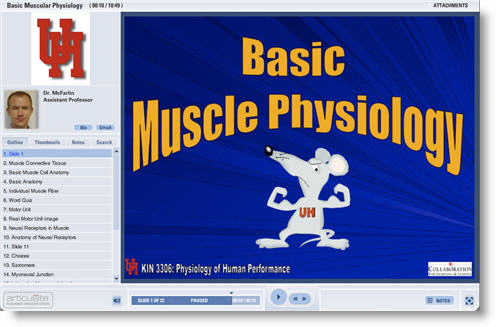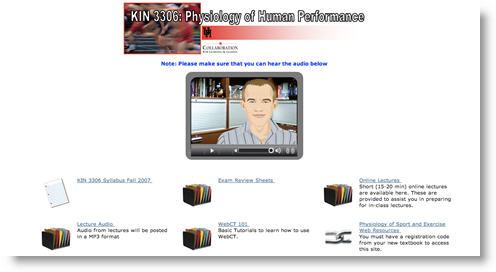Students Get Better Grades With Articulate-Powered Blended Learning
You’ve probably heard the term blended learning before. You may even use it in your own organization or school. Simply, it’s the act of combining two or more forms of learning — for example, classroom training and elearning — to create a comprehensive learning experience for students. And now it’s official: Using Articulate-powered elearning courses, combined with traditional classroom learning, increases student grades a full letter, according to a new study from the University of Houston:
A technical report from a University of Houston Department of Health and Human Performance researcher finds that students in a hybrid class that incorporated instructional technology with in-class lectures scored a letter grade higher on average than their counterparts who took the same class in a more traditional format.
 Dr. Brian McFarlin is the University of Houston professor who taught the comparative classes and conducted the study in which he taught one Kinesiology 3306 class via the traditional, classroom-only method (meeting twice per week) and pitted student results in it against student results in the same Kinesiology 3306 class that incorporated both classroom (meeting once per week) and Articulate-powered elearning.
Dr. Brian McFarlin is the University of Houston professor who taught the comparative classes and conducted the study in which he taught one Kinesiology 3306 class via the traditional, classroom-only method (meeting twice per week) and pitted student results in it against student results in the same Kinesiology 3306 class that incorporated both classroom (meeting once per week) and Articulate-powered elearning.
We asked Dr. McFarlin some questions about the study:
1. Besides the obvious gratification of improved grades, what other feedback did you receive from students, in particular related to the Articulate-authored courses?
Formally (in surveys) and informally the students really liked the flexibility that the Articulate-authored lectures allow. In particular, they like that they could stop in the middle and pick up where they left off later on. They also really liked how I embedded self-test quiz questions throughout the lectures. Finally they like having the ability to search the presentation for a particular topic. In addition to the presentation, I always offer the students a downloadable story board that they can take with them.
2. Have other professors / classes followed your model? Have they received similar results?
To my knowledge I am the only faculty member using Articulate in my college. I have been singing its praises for some time now (well over a year) and it appears that two of my colleagues have followed my lead and have begun using it. In addition to the course that this report was based on (KIN3306), I have gradually begun to incorporate this technology into my other online courses (KIN1304). The results have been very favorable. We will be targeting additional undergraduate classes in the future.
3. Do you have any student feedback you can share with us about the use of Articulate software and its role in the class?
Here are just a few quotes that pertain to the online lectures:
“Great teacher, smart. I really enjoyed all the online work. Made learning fun and easier.”
“I loved the organized structure of the class as well as the slides/ WebCT website.”
“The hybrid format was an asset and helped me learn in various ways. It allowed for a more in-depth form of studying and helped my grade.”
“The course was presented in a very interesting format with the in class and online fusion. I believe that the material presented did a very good job of giving one the grade they earned. Overall, a great and informative class.”
“Prof McFarlin is an exceptional teacher. He made the material understandable. His WebCT work was flawless and he always responded. Overall, this was my best class this semester.”
“The availability of class materials to review on WebCT contributed to my success in this course. Lecture audio was extremely helpful to review before exams.”
“The professor gave all the resources and tools to help students succeed in this class. Instructor was extremely knowledgeable and informative.”
“It was very useful to have the lectures online from class (the recording) and the different ways to access all the information needed.”
“I liked the fact that the class was a hybrid. He gave you all the tools you could possibly imagine to be successful in this class given that we only meet once a week. He was extremely knowledgeable about the subject and I feel I was able to learn a great deal in here.”
 4. How easy was our software to use? How was the integration with WebCT? Had you tried other authoring tools prior to Articulate? How did they compare?
4. How easy was our software to use? How was the integration with WebCT? Had you tried other authoring tools prior to Articulate? How did they compare?
The main reason I chose Articulate was the ease of use. When I first started producing lectures, I used the voice narration function in PowerPoint and then Impatica that UH purchases to publish it for WebCT. While this worked, it was very difficult to use because you have to really record the whole presentation at the same time. In my case I am not a professional when it comes to elearning so I often need to record slides multiple times. Articulate is much better because you are able to record the slides one at a time. In addition to Impatica I also used Camtasia for a time, but it fell to the same problems as Impatica. I found Articulate on the web, downloaded the demo and was hooked. The integration with WebCT is great. I use the SCORM-compliant format, which allows me to track student responses to the “self-test” questions that I embed in the online lectures. From my experience, if you can use PowerPoint then the learning curve to using Articulate is minimal (I did not even read the manual — just tried it out).
 5. You indicated that creating online course material is time consuming? Has that time decreased? Has our software assisted in that?
5. You indicated that creating online course material is time consuming? Has that time decreased? Has our software assisted in that?
Yes and no. Creating materials is still time consuming initially and I am not sure much can be done to change that. Where Articulate plays a big part is with updating. Now I can update a single slide and keep the rest of the recorded presentation. For instance, this past fall I updated all eight of my online lectures in about 12 hours to make a single lecture the first time. So this is a huge time savings.
6. Are there some courses that are not well suited to a hybrid approach?
I personally think that the hybrid format is the wave of the future. It allows the professor to leverage the flexibility of the web, while maintaining the structure of a traditional face-to-face class. I think that eventually most traditional lecture classes will move to a hybrid format. I think that professors tend to prefer this approach for upper division classes, while reserving fully online courses for lower division offerings. I have really enjoyed using the hybrid approach and am gradually infusing it into all of the classes that I teach. Of course, the initial undertaking for such a transition can be overwhelming, but this burden can be eased if you work with an instructional designer. Students like the hybrid format because it is more flexible for their busy schedules and allows them more access to the content in a course.
7. Were there any other unexpected benefits that were realized?
I was surprised that the increase in student grades was so dramatic. I thought the students may do a little better, but I would not have anticipated the outcome that I saw. I thought that it might be the same or slightly improved. I am all about helping students succeed and reach their goals, thus I am completely sold on hybrid instruction. My next objective is to make sure that every professor knows how powerful this approach can be. I am really addicted to developing quality elearning experiences for my students, which is a good thing for them.
Thanks, Dr. McFarlin, for taking the time to share your story with us. Something tells me that students who register for your classes in the future are going to insist on the version that incorporates the Articulate-powered courses.

7 responses to “Students Get Better Grades With Articulate-Powered Blended Learning”
Congratulations to Dr. McFarlin for taking a leadership role in quantifying the benefits of new teaching approaches. While many instructors are threatened by non-traditional teaching methods, Dr. McFarlin reveals the significant benefits of instructional technology. This impactful YouTube video – A Vision of Students Today: http://www.youtube.com/watch?v=dGCJ46vyR9o suggests that we have to continue to look at ways to reach today’s youth. Traditional methods will no longer work!
Thank you for your kind words. I have always been interested in helping students learn and reach their full potential. For me, this report validates everything that I always believed to be true, but could not prove. Hybrid and Online instruction is the wave of the future in my humble opinion. Hopefully more people will embrace it as time goes on.
I love that You Tube Video, I have seen that before. Thank you again!!
[…] week I posted a blog entry about how using a blended learning approach in academia can earn students better grades. This week I bring you a case study on a blended learning approach in the corporate world — […]
[…] this success story to the recent University of Houston example of how they’re using Articulate, and it’s clear that Articulate can play a significant […]
[…] of integrating elearning into a training program — and that elearning can even lead to better grades for students — but what about the environmental […]
Yes, I agree! that students learn better! They have 24 hour teacher support that fits their schedules. I started teaching hybrid in TExas on WEb CT and found it great. Getting ARticulate opened the world to students for personalized class computer assisted learning. I have seen students who struggle increase their accomplishments by using the many interactive parts to my class.
I am now using D2L with articulate. I am having problems with the new upgrade of D2L or something. Does any one have any ideas of how to relate the current together so I can keep my program going this fall? The modules won’t upload any more and index.html doesn’t load the programs when connected in file manager.
[…] and applied it to her physics classes. She introduced a hybrid learning approach similar to what Brian McFarlin offers at the University of […]
Comments are closed on this post. Need more help? Post your question in the E-Learning Heroes Discussions.